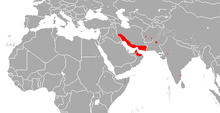Small mouse-tailed bat
| Small mouse-tailed bat | |
|---|---|

| |
| Scientific classification | |
| Domain: | Eukaryota |
| Kingdom: | Animalia |
| Phylum: | Chordata |
| Class: | Mammalia |
| Order: | Chiroptera |
| Family: | Rhinopomatidae |
| Genus: | Rhinopoma |
| Species: | R. muscatellum
|
| Binomial name | |
| Rhinopoma muscatellum Thomas, 1903
| |

| |
| Small mouse-tailed bat range | |
The small mouse-tailed bat (Rhinopoma muscatellum) is a species of bat in the Rhinopomatidae family. It is found in Afghanistan, Iran, Oman, and possibly Ethiopia, ranging from the Sistan Basin in Iran well into the Helmand River basin of south-western Afghanistan.[2]
Small mouse tailed bats have a wingspan of 17–25 cm (6.7–9.8 in), a body length of 6–8 cm (2.4–3.1 in) and a tail the same length as its body. Their diet consists of flying insects which they eat whilst flying.
This species was demonstrated as distinct from R. hardwickei based on mutually exclusive morphological features; the small mouse-tailed bat has a nearly unridged skull with small teeth and large cavities filled with fluid.[2]
Distance to roads-railways, annual mean temperature, elevation, and distance to the ridge were significant for the small mouse-tailed bat.[3]
References
[edit]- ^ Srinivasulu, B.; Srinivasulu, C. (2019). "Rhinopoma muscatellum". IUCN Red List of Threatened Species. 2019: e.T19602A21997131. doi:10.2305/IUCN.UK.2019-3.RLTS.T19602A21997131.en. Retrieved 17 November 2021.
- ^ a b DeBlase, Anthony F.; Schlitter, Duane A.; Neuhauser, Hans N. (1973). "Taxonomic Status of Rhinopoma muscatellum Thomas (Chiroptera: Rhinopomatidae) from Southwest Asia". Journal of Mammalogy. 54 (4): 831–841. doi:10.2307/1379078. JSTOR 1379078. PMID 4761366.
- ^ Schmitz, Patrick; Cibois, Alice; Landry, Bernard (October 2007). "Molecular phylogeny and dating of an insular endemic moth radiation inferred from mitochondrial and nuclear genes: The genus Galagete (Lepidoptera: Autostichidae) of the Galapagos Islands". Molecular Phylogenetics and Evolution. 45 (1): 180–192. Bibcode:2007MolPE..45..180S. doi:10.1016/j.ympev.2007.05.010. PMID 17604184.

